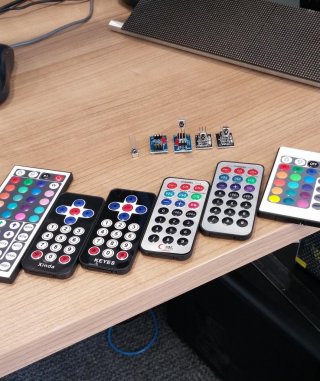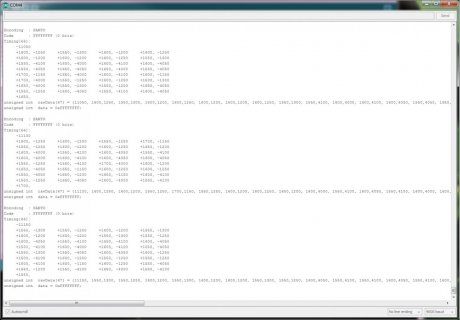Downloaded latest source from
https://github.com/z3t0/Arduino-IRremote
But I am getting compile errors:
In file included from C:\Program Files (x86)\Arduino\libraries\IRremote\IRremote.h:24:0,
from C:\Program Files (x86)\Arduino\libraries\IRremote\irISR.cpp:3:
C:\Program Files (x86)\Arduino\libraries\IRremote\irISR.cpp: In function 'void cmt_isr()':
C:\Program Files (x86)\Arduino\libraries\IRremote\IRremoteInt.h:473:10: warning: unused variable 'tmp' [-Wunused-variable]
uint8_t tmp = CMT_MSC; \
^
C:\Program Files (x86)\Arduino\libraries\IRremote\irISR.cpp:20:2: note: in expansion of macro 'TIMER_RESET'
TIMER_RESET;
^
In file included from C:\Program Files (x86)\Arduino\hardware\teensy\avr\cores\teensy3/core_pins.h:34:0,
from C:\Program Files (x86)\Arduino\hardware\teensy\avr\cores\teensy3/wiring.h:33,
from C:\Program Files (x86)\Arduino\hardware\teensy\avr\cores\teensy3/WProgram.h:15,
from C:\Program Files (x86)\Arduino\hardware\teensy\avr\cores\teensy3/Arduino.h:1,
from C:\Program Files (x86)\Arduino\libraries\IRremote\IRremoteInt.h:24,
from C:\Program Files (x86)\Arduino\libraries\IRremote\IRremote.h:24,
from C:\Program Files (x86)\Arduino\libraries\IRremote\irRecv.cpp:1:
C:\Program Files (x86)\Arduino\libraries\IRremote\irRecv.cpp: In member function 'void IRrecv::enableIRIn()':
C:\Program Files (x86)\Arduino\hardware\teensy\avr\cores\teensy3/kinetis.h:1980:52: error: expression cannot be used as a function
#define CMT_CMD3 (*(volatile uint8_t *)0x40062008) // CMT Modulator Data Register Space High
^
C:\Program Files (x86)\Arduino\libraries\IRremote\IRremoteInt.h:524:2: note: in expansion of macro 'CMT_CMD3'
CMT_CMD3 = 0; \
^
C:\Program Files (x86)\Arduino\libraries\IRremote\irRecv.cpp:120:2: note: in expansion of macro 'TIMER_CONFIG_NORMAL'
TIMER_CONFIG_NORMAL();
^
In file included from C:\Program Files (x86)\Arduino\libraries\IRremote\IRremote.h:24:0,
from C:\Program Files (x86)\Arduino\libraries\IRremote\irRecv.cpp:1:
C:\Program Files (x86)\Arduino\libraries\IRremote\IRremoteInt.h:473:10: warning: unused variable 'tmp' [-Wunused-variable]
uint8_t tmp = CMT_MSC; \
^
C:\Program Files (x86)\Arduino\libraries\IRremote\irRecv.cpp:125:2: note: in expansion of macro 'TIMER_RESET'
TIMER_RESET;
^
Error compiling.
Does not seem to like CMT_CMD3
any ideas? (im using teensy 3.1 with Arduino 1.6.3)
Regards
Russell Pirie
https://github.com/z3t0/Arduino-IRremote
But I am getting compile errors:
In file included from C:\Program Files (x86)\Arduino\libraries\IRremote\IRremote.h:24:0,
from C:\Program Files (x86)\Arduino\libraries\IRremote\irISR.cpp:3:
C:\Program Files (x86)\Arduino\libraries\IRremote\irISR.cpp: In function 'void cmt_isr()':
C:\Program Files (x86)\Arduino\libraries\IRremote\IRremoteInt.h:473:10: warning: unused variable 'tmp' [-Wunused-variable]
uint8_t tmp = CMT_MSC; \
^
C:\Program Files (x86)\Arduino\libraries\IRremote\irISR.cpp:20:2: note: in expansion of macro 'TIMER_RESET'
TIMER_RESET;
^
In file included from C:\Program Files (x86)\Arduino\hardware\teensy\avr\cores\teensy3/core_pins.h:34:0,
from C:\Program Files (x86)\Arduino\hardware\teensy\avr\cores\teensy3/wiring.h:33,
from C:\Program Files (x86)\Arduino\hardware\teensy\avr\cores\teensy3/WProgram.h:15,
from C:\Program Files (x86)\Arduino\hardware\teensy\avr\cores\teensy3/Arduino.h:1,
from C:\Program Files (x86)\Arduino\libraries\IRremote\IRremoteInt.h:24,
from C:\Program Files (x86)\Arduino\libraries\IRremote\IRremote.h:24,
from C:\Program Files (x86)\Arduino\libraries\IRremote\irRecv.cpp:1:
C:\Program Files (x86)\Arduino\libraries\IRremote\irRecv.cpp: In member function 'void IRrecv::enableIRIn()':
C:\Program Files (x86)\Arduino\hardware\teensy\avr\cores\teensy3/kinetis.h:1980:52: error: expression cannot be used as a function
#define CMT_CMD3 (*(volatile uint8_t *)0x40062008) // CMT Modulator Data Register Space High
^
C:\Program Files (x86)\Arduino\libraries\IRremote\IRremoteInt.h:524:2: note: in expansion of macro 'CMT_CMD3'
CMT_CMD3 = 0; \
^
C:\Program Files (x86)\Arduino\libraries\IRremote\irRecv.cpp:120:2: note: in expansion of macro 'TIMER_CONFIG_NORMAL'
TIMER_CONFIG_NORMAL();
^
In file included from C:\Program Files (x86)\Arduino\libraries\IRremote\IRremote.h:24:0,
from C:\Program Files (x86)\Arduino\libraries\IRremote\irRecv.cpp:1:
C:\Program Files (x86)\Arduino\libraries\IRremote\IRremoteInt.h:473:10: warning: unused variable 'tmp' [-Wunused-variable]
uint8_t tmp = CMT_MSC; \
^
C:\Program Files (x86)\Arduino\libraries\IRremote\irRecv.cpp:125:2: note: in expansion of macro 'TIMER_RESET'
TIMER_RESET;
^
Error compiling.
Does not seem to like CMT_CMD3
any ideas? (im using teensy 3.1 with Arduino 1.6.3)
Regards
Russell Pirie



